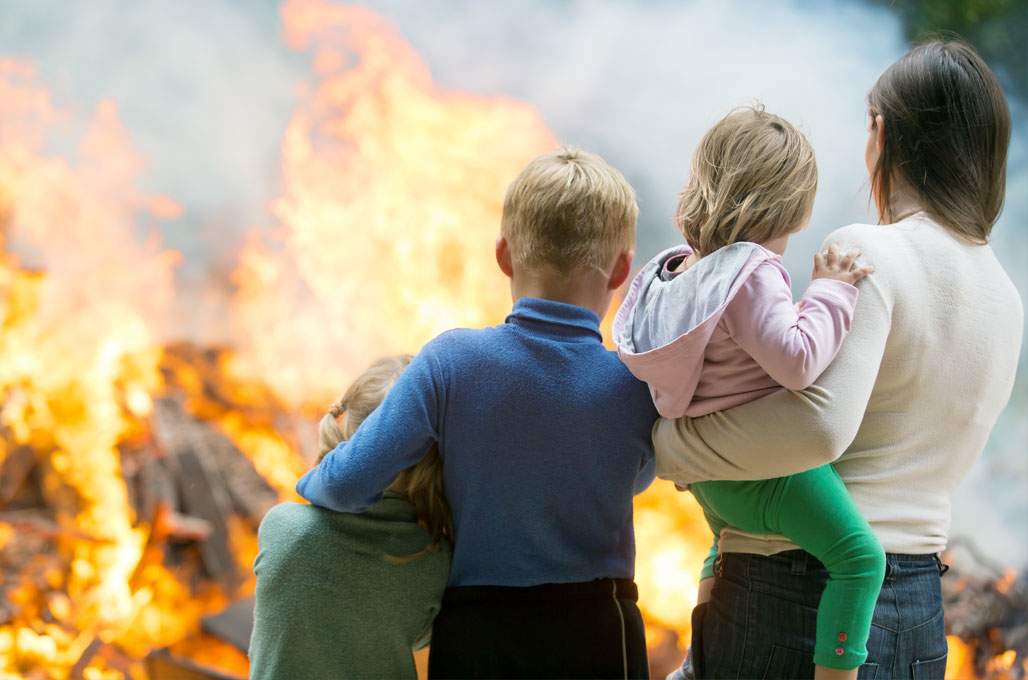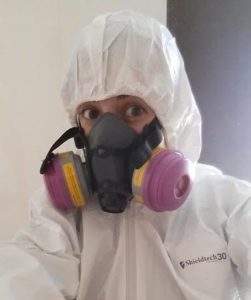Keeping Your Home Safe From Lead Contamination After a Structure Fire

If you have recently been the victim of a house fire, you know that the cleanup process can be a mess. On top of the water from fire hoses, chemicals from fire extinguishers, debris, ash, and soot, there are many particles that can’t even be seen by the naked eye. One of the most dangerous things that might be left behind in the form of these tiny particles after a structure fire is lead contamination.
During a structure fire, everything in your house is burning all at once. When you think of this as compared to the relatively safe smoke, ashes, and soot that come from your fireplace when you’re just burning wood, you can imagine that burning hundreds of types of materials produces smoke that is anything but safe. When lead is heated above 932 degrees Fahrenheit, lead vapor is released as highly toxic lead oxide fumes. After the fire, this solidifies and either remains floating in the air or settles in the form of ashes, soot, and other microscopic particles.
Of course you’ve heard of lead poisoning. It’s common knowledge that if you live in an older home (built before 1978), you have to be very careful about lead exposure. If you have young children or pets, exposure via ingestion of paint chips is particularly dangerous.
Thankfully, as awareness has increased and consumer expectations and building regulations along with it, less and less lead has been used in manufacturing and construction. However, that doesn’t mean that new buildings are devoid of lead entirely.
Unfortunately, when it comes to the inspection of structures after a fire, houses built after 1978 aren’t generally tested for lead during fire remediation and restoration. This can be problematic because other household items that contain lead likely were burned in the fire, causing a dangerous exposure environment.
In this blog, we will go over some common items you can find lead in as well as the effects of lead poisoning on the body, and what to do after a structure fire to ensure you’re safe from lead.
Sources of Lead Contamination
If your home was built before 1978, it likely has lead somewhere in its building materials. Lead pipes, as well as copper pipes and brass plumbing fixtures soldered with lead were very commonly used, and even if they are not posing any dangers to your drinking water, once those pipes melt in a fire, the situation changes entirely. The same is true for lead paint, which was extremely commonly used. While the biggest concern with lead paint is normally wear and tear causing paint chips, and thus endangering young children, this lead paint burns along with your walls in a structure fire.
Those are the concerns for homeowners with older homes, but there are still many objects in modern homes that may contain lead. Examples of household items that contain lead include:
- Toys – particularly those made in China, available in large discount stores, or old toys manufactured before 1985
- Cosmetics – up to 60% of lipstick has been found to be contaminated with lead
- Pottery – glazes on some ceramic items, porcelain, and china
- Soil – can become contaminated from leaded gasoline and remains contaminated for a long time
- Imported canned goods – while lead is illegal in US canned food, not all countries have this regulation
- Lead ammunition
- Diving and fishing weights and lures
- Batteries
- Electronics
- Jewelry
- Antiques
Because of the wide range of household items that may contain lead, it is likely that some lead is burned in many house fires. In addition, most people have no idea whether they own things containing lead, so testing for lead after a fire is the only real way to know whether you and your family are now at risk of lead poisoning.
Symptoms of Lead Poisoning
Most of the time, lead poisoning occurs slowly, as lead builds up in the body from a source. According to the Mayo Clinic, “signs and symptoms usually don’t appear until dangerous amounts have accumulated.” Because of the ease with which microscopic particles left behind by a fire can enter your lungs and bloodstream, this process can move more quickly if there is a lot of lead in your environment. However, the rate at which lead makes its way into your system can vary, as can primary symptoms, so it is very hard to know exactly when lead poisoning begins.
All that to say, it is important to know what lead poisoning looks like so that you understand how severe it is, but it is better safe than sorry when it comes to testing for lead contamination.
Lead can be absorbed via ingestion, inhalation, and dermal contact. So any particles in the air, on or around dishes or food preparation areas, in water, and on surfaces you touch are dangerous and could lead to lead poisoning.
Short-term lead poisoning, which can occur as a result of overexposure during a short period of time (like after a fire) can become fatal very quickly. It can lead to acute encephalopathy, which causes seizures, coma, and death due to cardiorespiratory arrest. Even if this condition is not acute, encephalopathy can cause a huge range of serious issues, many related to the functioning of the brain.
If the ingestion and absorption of lead is not so severe that it causes life threatening symptoms in the short-term, it can still cause a huge number of issues over time.
Lead is the most dangerous to children under 6 years of age, as it can severely impact their development. Signs of lead poisoning in children include:
- Gastrointestinal distress – vomiting, constipation, weight loss, loss of appetite, abdominal pain
- Developmental delays and learning difficulties
- Sluggishness, fatigue, and irritability
- Hearing loss
- Seizures
- Pica – eating things that aren’t food
In addition to children, lead poisoning is especially dangerous to a fetus, and can lead to premature birth, low birth weight, and slowed growth.
In adults, lead poisoning presents with a variety of symptoms, varying from minor problems to death. Symptoms include:
- High blood pressure
- Headaches
- Trouble concentrating and memory problems
- Muscle and joint pain
- Abdominal pain
- Mood swings
- Fertility issues, including reduced sperm count, miscarriage, stillbirth, and premature birth
How to Avoid Lead Poisoning After a Fire

It can help greatly to have an experienced fire damage remediation and restoration company on your side. Not all such companies focus on lead testing in newer homes, so make sure that you insist upon it. Abbotts Fire and Flood puts you and your family’s safety first, and we will use our expertise to ensure all dangerous contaminants are properly cleaned up after a structure fire.
If you need to get your home back to a safe and habitable condition following a structure fire, please give us a call. We are available 24/7 in case of emergencies, and will work directly with your homeowner’s insurance to ensure no corners are cut when it comes to getting your home properly cleaned up. Contact us today to learn more.
ADDITIONAL RESOURCES
https://www.randrmagonline.com/articles/88641-lead-contamination-in-structure-fires
https://www.ecowatch.com/11-ways-you-could-be-exposed-to-lead-in-your-everyday-life-1882176379.html
https://www.mayoclinic.org/diseases-conditions/lead-poisoning/symptoms-causes/syc-20354717

